INSTITUT SUPERIEUR D'ANTHROPOLOGIE
INSTITUTE OF ANTHROPOLOGY
ITALIE – 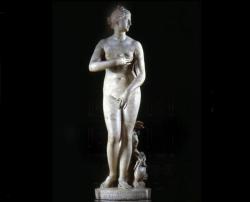 Red lipstick once shimmered on the lips of the Medici Venus, according to chemical analysis on the 2,000-year-old marble statue representing the Greek goddess of love Aphrodite. The investigation, carried out at the University of Modena and Reggio and the Uffizi Gallery in Florence, where the statue has been on display since 1677, indicates that the life-sized naked and sensual Venus originally had red lips and hair laminated with gold. To strenghten the effect, the naked statue also wore precious earrings, as newly discovered earlobe holes suggest. One of the most copied statues of all time, the Medici Venus -- itself a 1st century BC copy of a Greek bronze statue -- is the oldest sculpture in the Uffizi Gallery. How and where the statue was discovered is unkown. First recorded in 1638 in the Villa Medici in Rome, it was sent to Florence in 1677 and became the icon of the Grand Tour, the cultural journey of Europe undertaken in the 18th century by young, upper-class men.
Red lipstick once shimmered on the lips of the Medici Venus, according to chemical analysis on the 2,000-year-old marble statue representing the Greek goddess of love Aphrodite. The investigation, carried out at the University of Modena and Reggio and the Uffizi Gallery in Florence, where the statue has been on display since 1677, indicates that the life-sized naked and sensual Venus originally had red lips and hair laminated with gold. To strenghten the effect, the naked statue also wore precious earrings, as newly discovered earlobe holes suggest. One of the most copied statues of all time, the Medici Venus -- itself a 1st century BC copy of a Greek bronze statue -- is the oldest sculpture in the Uffizi Gallery. How and where the statue was discovered is unkown. First recorded in 1638 in the Villa Medici in Rome, it was sent to Florence in 1677 and became the icon of the Grand Tour, the cultural journey of Europe undertaken in the 18th century by young, upper-class men.
http://news.discovery.com/history/medici-venus-120203.html
SYRIE – 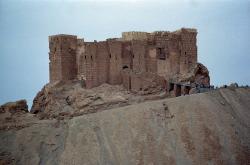 Palmyre - One report to surface last week, however, tells the story of Palmyra, where residents say the Syrian Army has set up camp in a citadel that overlooks both the modern city of 60,000 and the adjacent Roman ruins. Before the uprising, Palmyra was one of Syria’s biggest tourism attractions. Over the past month, though, hundreds of people have fled the city for safety. “Palmyra is surrounded by the army from all fronts: The Arab citadel, the olive and palm tree groves, the desert, the city,” an escaped resident told the Agence France-Presse. “Machine gun fire rains down from the citadel at anything that moves in the ruins because they think it is rebels.” Palmyra, once known as the “Bride of the Desert,” stood at the crossroads of several civilizations and was an important caravan stop on the Silk Road. Inscribed to the UNESCO World Heritage List in 1980, its monumental ruins include a unique collection of Greco-Roman art and architecture fused with local traditions and Persian influences.Until February, Palmyra had been spared the deadly violence that has spread across Syria. But since national security forces arrived in the city, residents who have managed to escape have spoken of daily machine gun and tank fire. War and conflict are certainly not the first threats to Syria’s cultural heritage sites, but reports of actual gunfire on the ruins is a grave concern.
Palmyre - One report to surface last week, however, tells the story of Palmyra, where residents say the Syrian Army has set up camp in a citadel that overlooks both the modern city of 60,000 and the adjacent Roman ruins. Before the uprising, Palmyra was one of Syria’s biggest tourism attractions. Over the past month, though, hundreds of people have fled the city for safety. “Palmyra is surrounded by the army from all fronts: The Arab citadel, the olive and palm tree groves, the desert, the city,” an escaped resident told the Agence France-Presse. “Machine gun fire rains down from the citadel at anything that moves in the ruins because they think it is rebels.” Palmyra, once known as the “Bride of the Desert,” stood at the crossroads of several civilizations and was an important caravan stop on the Silk Road. Inscribed to the UNESCO World Heritage List in 1980, its monumental ruins include a unique collection of Greco-Roman art and architecture fused with local traditions and Persian influences.Until February, Palmyra had been spared the deadly violence that has spread across Syria. But since national security forces arrived in the city, residents who have managed to escape have spoken of daily machine gun and tank fire. War and conflict are certainly not the first threats to Syria’s cultural heritage sites, but reports of actual gunfire on the ruins is a grave concern.
http://popular-archaeology.com/issue/march-2012/article/syrian-army-attacks-palmyras-roman-ruins
TURQUIE – 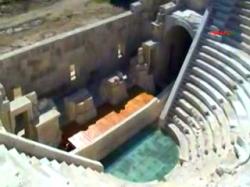
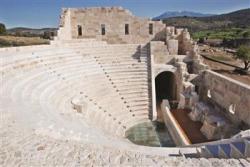 Patara - The 2-year restoration of the Lycian League Parliament building in the ancient city of Patara in the southern province of Antalya’s Kaş district has been completed. The Lycian League Parliament, which is regarded as the world’s first democratic Parliament, was discovered during the excavations carried out by the Akdeniz University Archaeology Department Professor Fahri Işık in 1991 and was brought to light by Professor Taner Korkut. The historic building was built in the first century A.D. and served as a Parliament building for 500 years. A project has been prepared by the Antalya Committee for the Protection of Cultural and Natural Beings for the restoration of the 43-meter-long and 30-meter-wide building with a capacity of 400 people. In his book ‘The Spirit of Laws’ French intellectual Montesquieu says ‘I show the Lycian League if I give an example of a perfect democracy from the ancient ages.’
Patara - The 2-year restoration of the Lycian League Parliament building in the ancient city of Patara in the southern province of Antalya’s Kaş district has been completed. The Lycian League Parliament, which is regarded as the world’s first democratic Parliament, was discovered during the excavations carried out by the Akdeniz University Archaeology Department Professor Fahri Işık in 1991 and was brought to light by Professor Taner Korkut. The historic building was built in the first century A.D. and served as a Parliament building for 500 years. A project has been prepared by the Antalya Committee for the Protection of Cultural and Natural Beings for the restoration of the 43-meter-long and 30-meter-wide building with a capacity of 400 people. In his book ‘The Spirit of Laws’ French intellectual Montesquieu says ‘I show the Lycian League if I give an example of a perfect democracy from the ancient ages.’
VIDEO = http://www.hurriyetdailynews.com/Default.aspx?pageID=428&VideoID=211
USA – 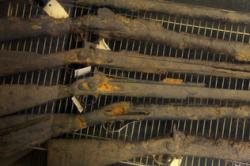 Kure Beach - There are hundreds of shipwrecks along North Carolina's treacherous coast, and some, like those of the ironclad USS Monitor or the Blackbeard flagship Queen Anne's Revenge, are famous. But that of the hapless Civil War blockade runner Modern Greece, which sits just beyond the surf near Fort Fisher, is in many ways the most important. The wreck, which was excavated 50 years ago, led to the creation of the state underwater archaeology unit that studies the other wrecks. It led to a state law to protect historic wreck sites from pilfering. It yielded such a large trove of artifacts that many have been used in experiments that advanced the tricky science of how to preserve historical treasures found underwater. And this week - just in time for events marking the 150th anniversary of its sinking - thousands of artifacts from the Modern Greece were recovered from underwater. A team of East Carolina University graduate students and UNC Wilmington interns sponsored by the Friends of Fort Fisher waded into the muck of half-century-old storage tanks at the Department of Cultural Resources' Underwater Archaeology Branch facility on the grounds of the historic fort. Their job: Pull out the artifacts, clean and catalog them and put them in indoor tanks where they could finally begin to receive modern preservation treatment. And the archaeologists are planning a modest spring expedition to use the latest gear to examine the Modern Greece site and create a proper record of it.
Kure Beach - There are hundreds of shipwrecks along North Carolina's treacherous coast, and some, like those of the ironclad USS Monitor or the Blackbeard flagship Queen Anne's Revenge, are famous. But that of the hapless Civil War blockade runner Modern Greece, which sits just beyond the surf near Fort Fisher, is in many ways the most important. The wreck, which was excavated 50 years ago, led to the creation of the state underwater archaeology unit that studies the other wrecks. It led to a state law to protect historic wreck sites from pilfering. It yielded such a large trove of artifacts that many have been used in experiments that advanced the tricky science of how to preserve historical treasures found underwater. And this week - just in time for events marking the 150th anniversary of its sinking - thousands of artifacts from the Modern Greece were recovered from underwater. A team of East Carolina University graduate students and UNC Wilmington interns sponsored by the Friends of Fort Fisher waded into the muck of half-century-old storage tanks at the Department of Cultural Resources' Underwater Archaeology Branch facility on the grounds of the historic fort. Their job: Pull out the artifacts, clean and catalog them and put them in indoor tanks where they could finally begin to receive modern preservation treatment. And the archaeologists are planning a modest spring expedition to use the latest gear to examine the Modern Greece site and create a proper record of it.
http://www.charlotteobserver.com/2012/03/08/3078449/civil-war-shipwreck-yields-its.html
GRECE - Karpathos - Le bilan des fouilles, concernant un habitat minoen et des vestiges romains.
http://www.express.gr/news/politismos/571859oz_20120302571859.php3
GRECE - Découvertes archéologiques 2011 en Macédoine et Thrace : le bilan dressé lors des rencontres archéologiques des 1 et 2 mars 2012
Pella - Des objets saisis en octobre 2011 (et évalué à 11 millions d'euros) à la suite de fouilles clandestines proviennent de toute évidence du site de Pella et de la nécropole d'Archontiko..
http://www.express.gr/news/politismos/571859oz_20120302571859.php3
Vergina - 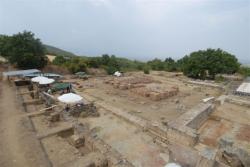
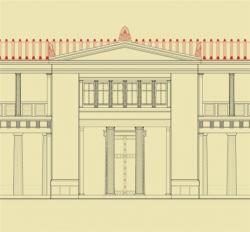 Des éléments du palais royal ont été réemployés pour la construction d'une basilique paléo-chrétienne.
Des éléments du palais royal ont été réemployés pour la construction d'une basilique paléo-chrétienne.
http://www.tovima.gr/culture/article/?aid=446175
Région de Kozani - Nombreuses découvertes de tombes et de mobilier funéraire (de l'âge du Bronze à l'époque hellénistique) dans les environs du fleuve Aliakmonas.
http://www.makthes.gr/news/arts/84592/
Ancienne Pydna - 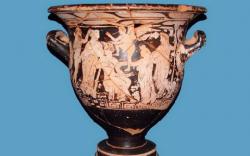 Découverte de tombes du IIIe av (lors d'une invasion des Galates) http://www.ethnos.gr/article.asp?catid=22784&subid=2&pubid=63622823#
Découverte de tombes du IIIe av (lors d'une invasion des Galates) http://www.ethnos.gr/article.asp?catid=22784&subid=2&pubid=63622823#
Apollonia - 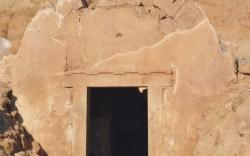 L'exploration du plus grand tombeau macédonien connu a donné peu de résultats, celui-ci ayant déjà été pillé ;
L'exploration du plus grand tombeau macédonien connu a donné peu de résultats, celui-ci ayant déjà été pillé ;
http://www.ethnos.gr/article.asp?catid=22784&subid=2&pubid=63622822
Sindos -  Le site déjà bien connu pour ses tombes de l'époque archaïque a livré des vestiges d'habitations ;
Le site déjà bien connu pour ses tombes de l'époque archaïque a livré des vestiges d'habitations ;
http://www.agelioforos.gr/default.asp?pid=7&ct=7&artid=129705
Thessalonique - 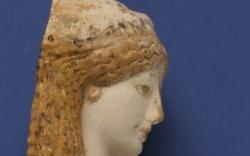
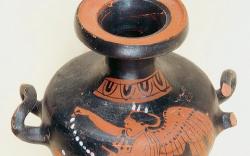 199 tombes, allant de l'époque du Bronze à la fin de l'Antiquité ont été fouillées ; le rempart a fait l'objet d'une étude méticuleuse :
199 tombes, allant de l'époque du Bronze à la fin de l'Antiquité ont été fouillées ; le rempart a fait l'objet d'une étude méticuleuse :
http://www.ethnos.gr/article.asp?catid=22784&subid=2&pubid=63623326# ; http://www.agelioforos.gr/default.asp?pid=7&ct=7&artid=129704
Une partie du décumanus maximus en service du IIIe au VIe ap et pavé de marbre a été dégagé dans le centre ville.
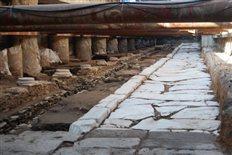
http://www.tanea.gr/politismos/article/?aid=4698817
USA – Phoenix - Local archaeologists revealed a vibrant and culturally diverse 19th century Phoenix Wednesday at the Arizona Science Center. The presentation focused on multiple urban digs that have taken place over the last several decades in central Phoenix. “Our results have been quite fascinating,” said Todd Bostwick, a researcher at Paleowest, an archaeological consulting firm in Phoenix. “To find something preserved under a parking lot after so many years is truly remarkable.” Bostwick’s research surprised much of the audience when it depicted a multiethnic Phoenix as far back as 1890. Evidence found in the digs suggests daily trade among the white population, Native Americans and a large population of Chinese immigrant workers was common at the time. Mark Hackbarth, a senior archaeologist, said the cultural diversity downtown was not limited to just race or ethnicity, but money as well. According to his records, rich and poor often lived side by side, something rarely seen today. “Right at the crux of change during the industrial revolution, many of the rich flocked to the city to build homes, taking their place beside the poor,” he said. Hackbarth specializes in the excavation of cellars and basements preserved underground. His presentation, “What Lies Beneath the Floor,” showed evidence of older, traditional buildings, paved over by newer brick homes. “Buildings were mostly adobe until railroads came through,” Hackbarth said. “This gave way to some of the modern brick homes we still see today.”
http://downtowndevil.com/2012/03/08/23854/phoenix-archaeoogy-history-diverse-science-center/